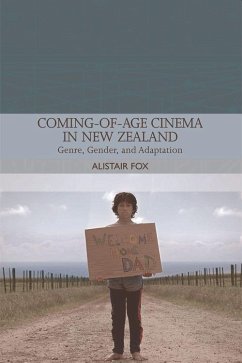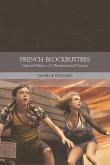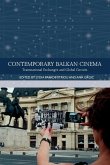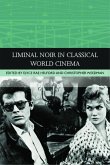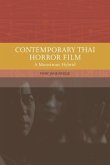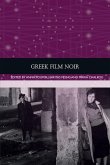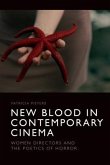- Broschiertes Buch
- Merkliste
- Auf die Merkliste
- Bewerten Bewerten
- Teilen
- Produkt teilen
- Produkterinnerung
- Produkterinnerung
This is the first book to investigate the coming-of-age genre as a significant phenomenon in New Zealand's national cinema, tracing its development and elucidating its role in cultural change.
Andere Kunden interessierten sich auch für
![French Blockbusters French Blockbusters]() Charlie MichaelFrench Blockbusters31,99 €
Charlie MichaelFrench Blockbusters31,99 €![Contemporary Balkan Cinema Contemporary Balkan Cinema]() Contemporary Balkan Cinema30,99 €
Contemporary Balkan Cinema30,99 €![Liminal Noir in Classical World Cinema Liminal Noir in Classical World Cinema]() Liminal Noir in Classical World Cinema139,99 €
Liminal Noir in Classical World Cinema139,99 €![Contemporary Thai Horror Film Contemporary Thai Horror Film]() Mary AinslieContemporary Thai Horror Film127,99 €
Mary AinslieContemporary Thai Horror Film127,99 €![Greek Film Noir Greek Film Noir]() Greek Film Noir35,99 €
Greek Film Noir35,99 €![The New Romanian Cinema The New Romanian Cinema]() The New Romanian Cinema37,99 €
The New Romanian Cinema37,99 €![New Blood in Contemporary Cinema New Blood in Contemporary Cinema]() Patricia PistersNew Blood in Contemporary Cinema33,99 €
Patricia PistersNew Blood in Contemporary Cinema33,99 €-
-
-
This is the first book to investigate the coming-of-age genre as a significant phenomenon in New Zealand's national cinema, tracing its development and elucidating its role in cultural change.
Hinweis: Dieser Artikel kann nur an eine deutsche Lieferadresse ausgeliefert werden.
Hinweis: Dieser Artikel kann nur an eine deutsche Lieferadresse ausgeliefert werden.
Produktdetails
- Produktdetails
- Traditions in World Cinema
- Verlag: Edinburgh University Press
- Seitenzahl: 288
- Erscheinungstermin: 28. Februar 2019
- Englisch
- Abmessung: 230mm x 167mm x 8mm
- Gewicht: 412g
- ISBN-13: 9781474429450
- ISBN-10: 1474429459
- Artikelnr.: 53687721
- Herstellerkennzeichnung
- Libri GmbH
- Europaallee 1
- 36244 Bad Hersfeld
- gpsr@libri.de
- Traditions in World Cinema
- Verlag: Edinburgh University Press
- Seitenzahl: 288
- Erscheinungstermin: 28. Februar 2019
- Englisch
- Abmessung: 230mm x 167mm x 8mm
- Gewicht: 412g
- ISBN-13: 9781474429450
- ISBN-10: 1474429459
- Artikelnr.: 53687721
- Herstellerkennzeichnung
- Libri GmbH
- Europaallee 1
- 36244 Bad Hersfeld
- gpsr@libri.de
Alistair Fox is Emeritus Professor at the University of Otago. He has published widely on topics in both literature and cinema, and most recently is the author of Jane Campion: Authorship and Personal Cinema (2011), Speaking Pictures: Neuropsychoanalysis and Authorship in Film and Literature (2016), and Coming of Age Cinema in New Zealand (EUP, 2017).
Preface
Part 1. The Coming-of-Age Genre and National Cinema
Chapter 1. The Coming-of-Age Film as a Genre: Attributes, Evolution, and
Functions
Chapter 2. New Zealand Coming-of-Age Films: Distinctive Characteristics and
Thematic Preoccupations
Part 2. The New Zealand New Wave: 1976-1989
Chapter 3. The Formation of a Budding Man Alone: The God Boy (Murray Reece,
1976)
Chapter 4. An Angry Young Man Seeks to Justify Himself: Sleeping Dogs (Ian
Donaldson, 1977)
Chapter 5. An Immigrant Filmmaker Substitutes an Alternative Vision of
Adolescence: The Scarecrow (Sam Pillsbury, 1982)
Chapter 6. Art-Cinema, Cultural Dislocation, and the Entry into Puberty:
Vigil (Vincent Ward, 1984)
Chapter 7. A Maori Girl Watches, Listens, and Learns - Coming of Age from
an Indigenous Viewpoint: Mauri (Merata Mita, 1988)
Part 3. The Second Wave of the 1990s
Chapter 8. Creativity as a Haven: An Angel at My Table (Jane Campion, 1990)
Chapter 9. Desperation Turned Outwards: Heavenly Creatures (Peter Jackson,
1994)
Chapter 10. Confronting Domestic Violence and Familial Abuse: Once Were
Warriors (Lee Tamahori, 1994)
Part 4. Preoccupations of the New Millennium
Chapter 11. An Adolescent Girl Experiments with Sexuality: Rain (Christine
Jeffs, 2001)
Chapter 12. Asserting Feminist Claims within Maori Culture: Whale Rider
(Nicki Caro, 2002)
Chapter 13. Family Secrets and Their Destructive Consequences: In My
Father's Den (Brad McGann, 2004)
Chapter 14. A Gay Boy Comes to Terms with His Sexuality: 50 Ways of Saying
Fabulous (Stewart Main, 2005)
Part 5. Perspectives on Maori Culture since 2010
Chapter 15. Parental Abandonment and the Trauma of Loss: Boy (Taika
Waititi, 2010)
Chapter 16. A Maori Boy Contests the Old Patriarchal Order: Mahana (Lee
Tamahori, 2016)
Chapter 17. Delinquency and Bicultural Relations: Hunt for the Wilderpeople
(Taika Waititi, 2016)
Conclusion
Bibliography
Index
Part 1. The Coming-of-Age Genre and National Cinema
Chapter 1. The Coming-of-Age Film as a Genre: Attributes, Evolution, and
Functions
Chapter 2. New Zealand Coming-of-Age Films: Distinctive Characteristics and
Thematic Preoccupations
Part 2. The New Zealand New Wave: 1976-1989
Chapter 3. The Formation of a Budding Man Alone: The God Boy (Murray Reece,
1976)
Chapter 4. An Angry Young Man Seeks to Justify Himself: Sleeping Dogs (Ian
Donaldson, 1977)
Chapter 5. An Immigrant Filmmaker Substitutes an Alternative Vision of
Adolescence: The Scarecrow (Sam Pillsbury, 1982)
Chapter 6. Art-Cinema, Cultural Dislocation, and the Entry into Puberty:
Vigil (Vincent Ward, 1984)
Chapter 7. A Maori Girl Watches, Listens, and Learns - Coming of Age from
an Indigenous Viewpoint: Mauri (Merata Mita, 1988)
Part 3. The Second Wave of the 1990s
Chapter 8. Creativity as a Haven: An Angel at My Table (Jane Campion, 1990)
Chapter 9. Desperation Turned Outwards: Heavenly Creatures (Peter Jackson,
1994)
Chapter 10. Confronting Domestic Violence and Familial Abuse: Once Were
Warriors (Lee Tamahori, 1994)
Part 4. Preoccupations of the New Millennium
Chapter 11. An Adolescent Girl Experiments with Sexuality: Rain (Christine
Jeffs, 2001)
Chapter 12. Asserting Feminist Claims within Maori Culture: Whale Rider
(Nicki Caro, 2002)
Chapter 13. Family Secrets and Their Destructive Consequences: In My
Father's Den (Brad McGann, 2004)
Chapter 14. A Gay Boy Comes to Terms with His Sexuality: 50 Ways of Saying
Fabulous (Stewart Main, 2005)
Part 5. Perspectives on Maori Culture since 2010
Chapter 15. Parental Abandonment and the Trauma of Loss: Boy (Taika
Waititi, 2010)
Chapter 16. A Maori Boy Contests the Old Patriarchal Order: Mahana (Lee
Tamahori, 2016)
Chapter 17. Delinquency and Bicultural Relations: Hunt for the Wilderpeople
(Taika Waititi, 2016)
Conclusion
Bibliography
Index
Preface
Part 1. The Coming-of-Age Genre and National Cinema
Chapter 1. The Coming-of-Age Film as a Genre: Attributes, Evolution, and
Functions
Chapter 2. New Zealand Coming-of-Age Films: Distinctive Characteristics and
Thematic Preoccupations
Part 2. The New Zealand New Wave: 1976-1989
Chapter 3. The Formation of a Budding Man Alone: The God Boy (Murray Reece,
1976)
Chapter 4. An Angry Young Man Seeks to Justify Himself: Sleeping Dogs (Ian
Donaldson, 1977)
Chapter 5. An Immigrant Filmmaker Substitutes an Alternative Vision of
Adolescence: The Scarecrow (Sam Pillsbury, 1982)
Chapter 6. Art-Cinema, Cultural Dislocation, and the Entry into Puberty:
Vigil (Vincent Ward, 1984)
Chapter 7. A Maori Girl Watches, Listens, and Learns - Coming of Age from
an Indigenous Viewpoint: Mauri (Merata Mita, 1988)
Part 3. The Second Wave of the 1990s
Chapter 8. Creativity as a Haven: An Angel at My Table (Jane Campion, 1990)
Chapter 9. Desperation Turned Outwards: Heavenly Creatures (Peter Jackson,
1994)
Chapter 10. Confronting Domestic Violence and Familial Abuse: Once Were
Warriors (Lee Tamahori, 1994)
Part 4. Preoccupations of the New Millennium
Chapter 11. An Adolescent Girl Experiments with Sexuality: Rain (Christine
Jeffs, 2001)
Chapter 12. Asserting Feminist Claims within Maori Culture: Whale Rider
(Nicki Caro, 2002)
Chapter 13. Family Secrets and Their Destructive Consequences: In My
Father's Den (Brad McGann, 2004)
Chapter 14. A Gay Boy Comes to Terms with His Sexuality: 50 Ways of Saying
Fabulous (Stewart Main, 2005)
Part 5. Perspectives on Maori Culture since 2010
Chapter 15. Parental Abandonment and the Trauma of Loss: Boy (Taika
Waititi, 2010)
Chapter 16. A Maori Boy Contests the Old Patriarchal Order: Mahana (Lee
Tamahori, 2016)
Chapter 17. Delinquency and Bicultural Relations: Hunt for the Wilderpeople
(Taika Waititi, 2016)
Conclusion
Bibliography
Index
Part 1. The Coming-of-Age Genre and National Cinema
Chapter 1. The Coming-of-Age Film as a Genre: Attributes, Evolution, and
Functions
Chapter 2. New Zealand Coming-of-Age Films: Distinctive Characteristics and
Thematic Preoccupations
Part 2. The New Zealand New Wave: 1976-1989
Chapter 3. The Formation of a Budding Man Alone: The God Boy (Murray Reece,
1976)
Chapter 4. An Angry Young Man Seeks to Justify Himself: Sleeping Dogs (Ian
Donaldson, 1977)
Chapter 5. An Immigrant Filmmaker Substitutes an Alternative Vision of
Adolescence: The Scarecrow (Sam Pillsbury, 1982)
Chapter 6. Art-Cinema, Cultural Dislocation, and the Entry into Puberty:
Vigil (Vincent Ward, 1984)
Chapter 7. A Maori Girl Watches, Listens, and Learns - Coming of Age from
an Indigenous Viewpoint: Mauri (Merata Mita, 1988)
Part 3. The Second Wave of the 1990s
Chapter 8. Creativity as a Haven: An Angel at My Table (Jane Campion, 1990)
Chapter 9. Desperation Turned Outwards: Heavenly Creatures (Peter Jackson,
1994)
Chapter 10. Confronting Domestic Violence and Familial Abuse: Once Were
Warriors (Lee Tamahori, 1994)
Part 4. Preoccupations of the New Millennium
Chapter 11. An Adolescent Girl Experiments with Sexuality: Rain (Christine
Jeffs, 2001)
Chapter 12. Asserting Feminist Claims within Maori Culture: Whale Rider
(Nicki Caro, 2002)
Chapter 13. Family Secrets and Their Destructive Consequences: In My
Father's Den (Brad McGann, 2004)
Chapter 14. A Gay Boy Comes to Terms with His Sexuality: 50 Ways of Saying
Fabulous (Stewart Main, 2005)
Part 5. Perspectives on Maori Culture since 2010
Chapter 15. Parental Abandonment and the Trauma of Loss: Boy (Taika
Waititi, 2010)
Chapter 16. A Maori Boy Contests the Old Patriarchal Order: Mahana (Lee
Tamahori, 2016)
Chapter 17. Delinquency and Bicultural Relations: Hunt for the Wilderpeople
(Taika Waititi, 2016)
Conclusion
Bibliography
Index

